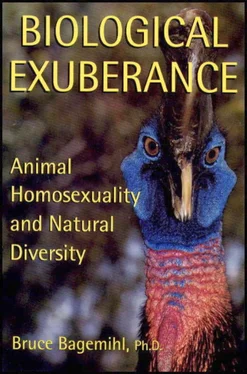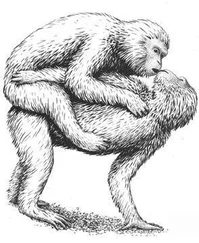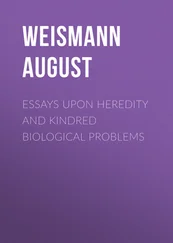13
While the word homophobia means, literally, an irrational fear of homosexuality, the term is also applied to instances of disgust, revulsion, hatred, or open hostility, as well as more subtle prejudicial feelings of discomfort, distaste, or dislike toward homosexuality or homosexual individuals (not necessarily accompanied by fear). For more discussion and further references on the nature and consequences of homophobia, see Blumenfeld, W. J., ed. (1992) Homophobia: How We All Pay the Price (Boston: Beacon Press).
14
Ruff (Selous 1906—7:420, 423); American Bison (McHugh 1958:25); Waterbuck (Spinage 1982:118).
15
The appellations abnormal, aberrant, unnatural, or perverted , for example, have been applied by scientists to homosexual behavior or transgender in at least 30 different species of mammals and birds (often in multiple sources for each species), and as recently as the mid-1980s in some published accounts (Kittiwake [Coulson and Thomas 1985:20]; Bighorn Sheep [Berger 1985]). Even more recently (Finley et al. 1997:914—15, 917), same-sex courtship and sexual activity in Fruit Flies (as well as refusal of heterosexual advances) have been characterized as “abnormal,” “aberrant,” and a “defect,” and similar terms have also been used by some zoologists in their personal communications with me. Somewhat less derogatory designations such as odd (including odd couples ), peculiar, irregular , or bizarre have been used to describe homosexuality or transgender in at least 15 other species of mammals and birds. Many other examples can of course be found in descriptions of reptiles, amphibians, fishes, insects, and other creatures. Heterosexual behaviors or individuals are characterized as “normal” in opposition to homosexual behaviors or individuals in the following published scientific sources, among others: Common Chimpanzee (Adang et al. 1987:242); Gorilla (Harcourt 1988:59); Kob (Buechner and Schloeth 1965:2219); Canada Goose (Collias and Jahn 1959:484); Black-winged Stilt (Kitagawa 1988a:64); Black-headed Gull (van Rhijn and Groothuis 1985:161); Lovebirds (Dilger 1960:667); Hooded Warbler (Niven 1994:192); Ostrich (Sauer 1972:729).
16
Gadeau de Kerville (1896); Grollet and L. Lepinay (1908) “L’inversion sexuelle chez les animaux” (Sexual Inversion in Animals), Revue de l’hypnotisme 23:34-37; Savanna Baboon (Marais 1922/1969); Bengalese Finch (Masatomi 1957); Ostrich (Sauer 1972); Long-eared Hedgehog (Poduschka 1981); Whiptail Lizard (Crews and Young 1991).
17
Mazarine Blue (Tennent 1987:81-82).
18
Domestic Cattle (Klemm et al. 1983:187); Elephants (Rosse 1892:799); Lion (Cooper 1942:26-28); Buff-breasted Sandpiper (Myers 1989); Domestic Turkey (Hale 1955:1059); Spinner Dolphin (Wells 1984:470); Killer Whale (Rose 1992:112); Caribou (Bergerud 1974:420); Adélie Penguin (Davis et al. 1998:137); Black-billed Magpie (Baeyens 1979:39-40); Guianan Cock-of the-Rock (Trail 1985a:238-39); Sage Grouse (Scott 1942:494). Other terms, while not necessarily derogatory, reflect scientists’ particular interpretations of such behavior as substitute or counterproductive activities: same-sex mounting in Gorillas is called “vicarious” sexual activity (Fossey 1983:74, 188—89), and homosexual mounting in African Buffalo is categorized as “barren sexual behavior” (Mloszewski 1983:186). See also the subsequent section “Mock Courtships and Sham Matings” for discussion of the widespread use of terms such as false or mock sexual behavior to characterize homosexual activity, and chapters 4 and 5 for other interpretations of homosexuality.
19
Long-eared Hedgehog (Poduschka 1981:84, 87); Eastern Gray Kangaroo (Grant 1974:74); Black-crowned Night Heron (Noble et al. 1938:29); King Penguin (Gillespie 1932:95, 98); Gorilla (Harcourt 1988:59); Lorikeets (Low 1977:24); Red Fox (Macdonald 1987:101); Greenshank (Nethersole-Thompson and Nethersole-Thompson 1979:112—13; Nethersole-Thompson 1951:109).
20
This is not to say, of course, that homosexual “advances” are never unwanted. Various forms of nonconsensual courtship or sexual approaches between animals of the same sex have been reported in about a quarter of the mammal and bird species exhibiting homosexuality. However, in many cases they co-occur with “consensual” homosexual interactions in the same species, from which they are clearly distinguished by behavioral indications of unwillingness on the part of one partner. As in nonconsensual heterosexual interactions (which are reported in more than a third of the species in which homosexual behavior has been documented and in general are equally, if not more, prevalent in animals—see chapter 5), there is actually a continuum of disinterest and “refusal” behavior. An animal may signal its unwillingness by not permitting any sexual approaches or contact at all, by permitting sexual contact but not facilitating the interaction, or by actively interrupting contact (either by trying to get away or by attacking the other animal). Assertions by scientists of “unwanted” homosexual attentions are usually anthropomorphic projections made regardless of whether such behavioral evidence is present (or what degree of nonconsensuality is involved).
21
Mountain Sheep (Geist 1975:100); Rhesus Macaque (Carpenter 1942:137, 151-52); Laughing Gull (Noble and Wurm 1943:205—6); Cattle Egret (Fujioka and Yamagishi 1981:139); Sage Grouse (Gibson and Bradbury 1986:396); Orang-utan (Rijksen 1978:264-65); Kob (Buechner and Schloeth 1965:211-12, 217, 219); Ostrich (Sauer 1972:729, 733); Guianan Cock-of-the-Rock (Trail and Koutnik 1986:210-11, 215); Mallard Duck (Schutz 1965:458); Rhesus Macaque (Kempf 1917:136). One zoologist also reveals something of his own misconceptions concerning both homosexual and heterosexual intercourse when he expresses surprise that a female Bonobo “on the bottom” during a lesbian interaction does not appear to mind—in fact, visibly enjoys—being in that position: “If we were on the bottom being held down, we would probably feel submissive and inferior, but female pygmy chimpanzees seem not to take it that way… the female on the bottom… looks proud and affectionate” (Kano 1992:193).
22
Greylag Goose (Huber and Martys 1993:161); see Lorenz (1991:241—42) on gander pairs being more closely bonded than heterosexual pairs.
23
Ocellated Antbird (Willis 1973:31); on heterosexual divorce in Antbirds, see Willis (1983:414).
24
Gorilla (Fischer and Nadler 1978:660-61); Western Gull (Hunt et al. 1984:160); Guianan Cock-of-the-Rock (Trail 1985a:238, 240); Red Fox (Macdonald 1987:101); de Waal 1989a:25 (Bonobo). For descriptions of nonstandard mounting positions (lateral, head-to-tail) in heterosexual contexts, see (for example) Japanese Macaque (Hanby and Brown 1974:156, 164); Boto (Best and da Silva 1989:15); Bottlenose/Spotted Dolphins (Herzing and Johnson 1997:92, 96); Waterbuck (Spinage 1969:41-42); Mountain Sheep (Geist 1971:139— 40); Mountain Goat (Hutchins 1984:268); Takhi (Boyd and Houpt 1994:202); Collared Peccary (Byers and Bekoff 1981:771); Warthog (Cumming 1975:118-19); Koala (Smith 1980c:48); Ruff (Hogan-Warburg 1966:176); Hammerhead (Brown 1982:171; Campbell 1983:11); Flamingo (Shannon 1985:229); Chaffinch (Marler 1956:114); red-winged blackbird (Monnett, C., L. M. Rotterman, C. Worlein, and K. Halupka [1984] “Copulation Patterns of Red-winged Blackbirds [ Agelaius phoeniceus ],” p.759, American Naturalist 124:757— 64). Of these, subjective or derogatory terms are only used in Monnett et al. 1984 (“abnormal,” “aberrant”) and Hutchins 1984 (“clumsy,” “awkward”). Nonstandard homosexual mounting positions such as sideways or head-to-tail mounts have usually been classified as “mistakes” or “incomplete” mounting attempts by zoologists who insist on viewing homosexual interactions only in terms of how closely they resemble “standard” heterosexual intercourse. In other words, anything that deviates from genital penetration (or cloacal contact in birds) in the front-to-back position used by males with females is an “error.” Because these mounting positions are often used by female animals (when they mount individuals of either sex), a further, sexist, interpretation is also frequently overlaid on these behaviors: it is claimed that they represent an “imperfect” attempt on the part of females to imitate male mounting behavior. An equally valid perspective, however, is that these represent alternative or more “fluid” sexual interchanges—not bound by the “requirement” of genital penetration—rather than flawed imitations of heterosexual postures. A parallel example can be found in the behavior of “sideways presenting” in female Crab-eating Macaques: previously classified as “disoriented” or “inadequate,” this posture was later found to be a systematic behavioral variant (Emory and Harris 1978). For further discussion and a critique of the widespread view that homosexuality is an imperfect approximation of heterosexuality, see chapter 4. For evidence that heterosexual sex is not focused exclusively on vaginal penetration and ejaculation, see chapter 5.
Читать дальше












